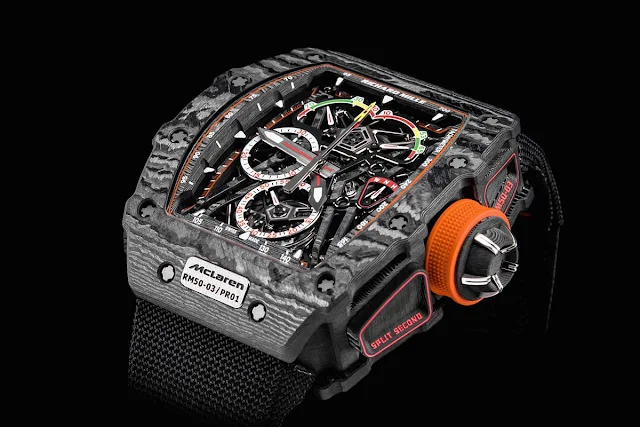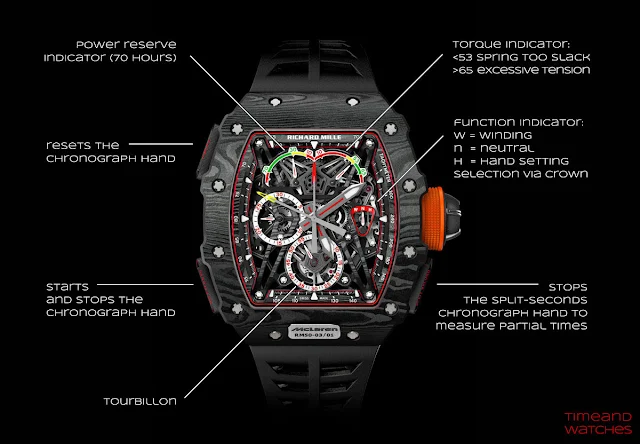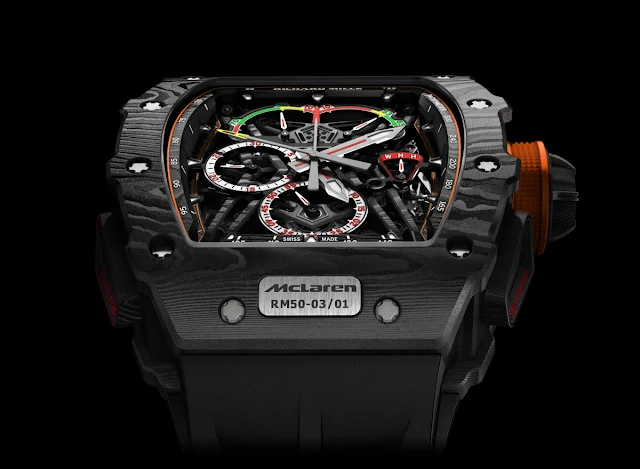SIHH 2017: Richard Mille - RM 50-03 McLaren F1. Produced in collaboration with the famed McLaren Formula 1 constructor, the new Richard Mille masterpiece achieves an exceptional record as the lightest mechanical chronograph ever made.
Combining a tourbillon with a split seconds chronograph, the RM 50-03 McLaren F1 weighs less than 40 grams, including the new strap.
The Richard Mille RM 50-03 McLaren F1 will be produced in a numbered limited edition of 75 pieces and will be available only at Richard Mille boutiques. The price? Not exactly cheap at Swiss Francs 980,000 but what did you expect from a F1 for the wrist? Novità Richard Mille al SIHH 2017
Produced in collaboration with the famed McLaren Formula 1 constructor, the new Richard Mille masterpiece achieves an exceptional record as the lightest mechanical chronograph ever made.
Combining a tourbillon with a split seconds chronograph, the RM 50-03 McLaren F1 weighs less than 40 grams, including the new strap.
This astonishing result has been achieved through the use of cutting-edge technical materials. The design not only incorporates Titanium and Carbon TPT, but also introduces an entirely new material into the world of watchmaking: Graph TPT, more commonly known as graphene.
These new applications for the material emerged through research at the National Graphene Institute, established in 2015 at The University of Manchester. It’s where graphene was first isolated by Professor Andre Geim of the School of Physics and Astronomy, back in 2004. For this discovery, in 2010 he was awarded with the Nobel Prize in physics, alongside his colleague, Professor Konstantin Novoselov.
Thanks to the collaborative work between The University of Manchester, McLaren Applied Technologies and long-time partner North Thin Ply Technology (NTPT), Richard Mille has succeeded in producing a watch case where the carbon’s physical properties of Carbon TPT were significantly enhanced by the introduction of graphene, a revolutionary nano-material which is six times lighter than steel, and 200 times stronger.
Noted for the beautiful, undulating striations of its surface, Carbon TPT is comprised of parallel filaments – 600 layers, in fact, whose maximum thickness is 30 microns. These are impregnated with a super-charged resin containing graphene, and are then compiled by a CNC machine that shifts the orientation of the fibres by 45° between layers.
The composite is then solidified by heating it to 120°C, at 6 Bar of pressure. Numerous control and validation tests conducted by McLaren Applied Technologies have made it possible to develop the solutions that resulted in the production of Graph TPT, a material employed exclusively by Richard Mille in the domain of watchmaking.
Ultra light is probably not enough to describe the 7-gram movement - yes, not a typo: just seven grams! The secret to its feather weight lies in the use of grade 5 Titanium and Carbon TPT for the baseplate and bridges, and in the extreme skeletonisation of components. Beating at 21,600 vibrations per hour, it offers 70 hours of power reserve.
Watchmaking expertise can be found throughout this movement with drawn, polished, satin-finished and soft-polished surfaces all created by hand.
A transverse cage, crafted of Carbon TPT and inspired by the wishbone suspension structure of a McLaren-Honda Formula 1 car, is affixed to the caseband, and supports the entire RM50-03 calibre.
By eliminating the casing ring, this unusual architecture enables a perfect fit between the movement and case. Taken together, these technical solutions provide the complex calibre with tremendous
resistance properties. Indeed, the casing has withstood shock loadings of 5,000g in Richard Mille’s tests.
In order to perform without fail, the combination of a tourbillon escapement with a split-seconds function within a single mechanism demands perfect transfers of energy. The ensuing need to reduce friction led to research on how to improve the profiling of the teeth on the barrel and gear train resulting in a perfectly balanced torque and optimised yield.
The movement’s performance and the quality of the energy delivered can be easily read via coloured indicators denoting the 70-hour energy reserve and torque sensor.
The hollow pushers of the chronograph are representative of the air intake ducts on the McLaren-Honda car, while the shape of the crown takes its cue from the racing competition wheel rims used by the British team.
Design of a new split-seconds mechanism and extensive research on the work of the split-seconds clamps have permitted a 50% reduction in the chronograph’s energy consumption, while at the same time reducing arbor friction.
While previous Richard Mille chronographs have traditionally featured a wheel with 8 columns, the one equipping the RM 50-03 now only has 6 columns to ensure optimised simultaneous movement, maximal function locking, and greater adjustment durability.
The case (44.50 mm x 49.65 mm x 16.10 mm) is water-resistant to 50 metres / 165 feet and assembled with 20 spline screws in grade 5 titanium permitting better control of the torque applied to the screws during assembly making them unaffected by physical manipulation during assembly or disassembly.
Graphene was also integrated into the rubber strap of the RM 50-03 to increase its elasticity and resistance to wear.
The Richard Mille RM 50-03 McLaren F1 will be produced in a numbered limited edition of 75 pieces and will be available only at Richard Mille boutiques.
Each watch will be accompanied by a 1:5 scale model of the 2017 McLaren-Honda racing car. The price? Not exactly cheap at Swiss Francs 980,000 but what did you expect from a F1 for the wrist? richardmille.com
Combining a tourbillon with a split seconds chronograph, the RM 50-03 McLaren F1 weighs less than 40 grams, including the new strap.
This astonishing result has been achieved through the use of cutting-edge technical materials. The design not only incorporates Titanium and Carbon TPT, but also introduces an entirely new material into the world of watchmaking: Graph TPT, more commonly known as graphene.
These new applications for the material emerged through research at the National Graphene Institute, established in 2015 at The University of Manchester. It’s where graphene was first isolated by Professor Andre Geim of the School of Physics and Astronomy, back in 2004. For this discovery, in 2010 he was awarded with the Nobel Prize in physics, alongside his colleague, Professor Konstantin Novoselov.
Thanks to the collaborative work between The University of Manchester, McLaren Applied Technologies and long-time partner North Thin Ply Technology (NTPT), Richard Mille has succeeded in producing a watch case where the carbon’s physical properties of Carbon TPT were significantly enhanced by the introduction of graphene, a revolutionary nano-material which is six times lighter than steel, and 200 times stronger.
The composite is then solidified by heating it to 120°C, at 6 Bar of pressure. Numerous control and validation tests conducted by McLaren Applied Technologies have made it possible to develop the solutions that resulted in the production of Graph TPT, a material employed exclusively by Richard Mille in the domain of watchmaking.
Watchmaking expertise can be found throughout this movement with drawn, polished, satin-finished and soft-polished surfaces all created by hand.
A transverse cage, crafted of Carbon TPT and inspired by the wishbone suspension structure of a McLaren-Honda Formula 1 car, is affixed to the caseband, and supports the entire RM50-03 calibre.
resistance properties. Indeed, the casing has withstood shock loadings of 5,000g in Richard Mille’s tests.
In order to perform without fail, the combination of a tourbillon escapement with a split-seconds function within a single mechanism demands perfect transfers of energy. The ensuing need to reduce friction led to research on how to improve the profiling of the teeth on the barrel and gear train resulting in a perfectly balanced torque and optimised yield.
The movement’s performance and the quality of the energy delivered can be easily read via coloured indicators denoting the 70-hour energy reserve and torque sensor.
While previous Richard Mille chronographs have traditionally featured a wheel with 8 columns, the one equipping the RM 50-03 now only has 6 columns to ensure optimised simultaneous movement, maximal function locking, and greater adjustment durability.
The case (44.50 mm x 49.65 mm x 16.10 mm) is water-resistant to 50 metres / 165 feet and assembled with 20 spline screws in grade 5 titanium permitting better control of the torque applied to the screws during assembly making them unaffected by physical manipulation during assembly or disassembly.
The Richard Mille RM 50-03 McLaren F1 will be produced in a numbered limited edition of 75 pieces and will be available only at Richard Mille boutiques.
Each watch will be accompanied by a 1:5 scale model of the 2017 McLaren-Honda racing car. The price? Not exactly cheap at Swiss Francs 980,000 but what did you expect from a F1 for the wrist? richardmille.com





















40 grams? It looks pretty heavy and large at first sight. Unbelievable.
ReplyDelete